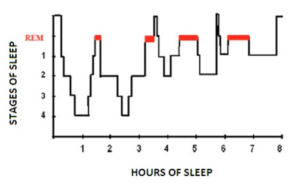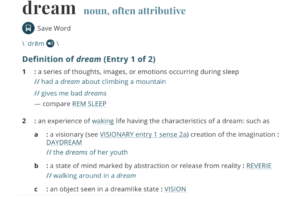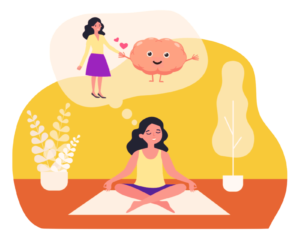As we dive into these little-known facts about lucid dreaming, let’s start with one about sleep and dreams in general:
We dream for more than 2 hours per night
On average, people need 7-9 hours of sleep per night. As we’ll cover further below, during sleep, the brain cycles through four stages of sleep every 90 minutes. The longer we stay asleep, the longer each REM period gets (see diagram below).
During the final sleep cycle of the night, the REM period can last for an entire hour. If we add up the total REM time from the entire night, we average around 120 minutes or two hours of REM sleep.
A common misconception is that we only dream during those two hours of REM sleep but this is not true.
The brain is active in all stages of sleep and there can be a subjective, experienced element to that activity. Though most people are not in the practice of being aware (lucid) during these states of consciousness, as you’ll see below, some people are able to maintain or reactivate consciousness during all stages of sleep. This is anecdotal evidence that we dream in non-REM states of sleep.
There are 4 stages of sleep
 Every 90 minutes throughout the night, we transition through a cycle of these 4 stages.
Every 90 minutes throughout the night, we transition through a cycle of these 4 stages.
Stage N1
Starting with stage N1 (N stands for Non-REM), which is very light sleep. This is considered a transitional phase of consciousness changing from wake to sleep. It is sometimes referred to as the hypnagogic state.
If you were in a room with someone who’s in N1 and you quietly said their name out loud, they would open their eyes and respond immediately, likely denying that they were asleep at all. This stage only lasts a few minutes before shifting into the next stage.
Stage N2
This brings us to stage N2. We spend around 50% of our entire night of sleep in this stage. In N2, we lose conscious awareness of physical sensations, and our surroundings (usually). If you were in the room with someone in stage N2 and you quietly said their name aloud, they might not respond right away – it may take a few tries to wake them up. This stage lasts around 20 minutes per cycle.
Stage N3
Next, we transition into stage N3; the deepest stage of sleep. Otherwise known as delta sleep, because brainwave activity is measured as delta waves (high amplitude, low-frequency waves) in an EEG (electroencephalogram). If you tried to wake someone up out of stage N3, you’d have difficulty doing so, and most likely that person wouldn’t remember it the next morning.
REM Sleep
And now we’ve made it to Rapid Eye Movement Sleep (REM sleep). This stage has been called paradoxical sleep because brain activity appears to be strikingly similar to activity while awake. The body goes into a temporary state of paralysis during this stage, theoretically, so we do not act our dreams out in bed.
This is the stage in which dreams are the most vivid, and when we talk about lucid dreaming, usually we’re referring to lucid dreams in REM sleep. Each REM period gets longer and longer as the night goes on and we continue cycling through these 4 stages.
Dreams are mental simulations
Check out the dictionary definition of dreams here:

From cultural references to subjective reports, there are many ways to describe dreams. But when it comes to the ontology of dreams – getting to a core understanding of what dreams fundamentally are – we should think of dreams as simulations.
A simulation can be defined as an imitation or representation of how a real-world process or system operates.
When we’re dreaming, while it seems like we are in the (or a type of) real world, we are not physically interacting with the outside, objective world around us. In dreams, we are engaging with a purely mental representation… imitation… or simulation of waking-life reality.
Dreams are a proxy for waking life situations, problems, desires, challenges, etc. At the level of the brain, dreams are indistinguishable from waking reality. We can learn, feel physical sensations, and experience intense emotions in the simulated reality of the dream world.
The Matrix did a great job of portraying a computer simulation of reality. One of my favorite facts about lucid dreaming is that the mind does a great job of generating a mental simulation of reality every night and we can wake up within the simulation and become Neo (the One).
But unlike The Matrix, we don’t need to be ‘plugged in’ to be fully immersed in this high resolution, multi-sensory mental simulation — all we need to do is go to sleep and get lucid.

Dreams help us process emotions
Nearly every single psychiatric mood disorder has a sleep abnormality associated with it. And often, REM sleep is the sleep stage most affected. REM sleep helps us consolidate memories and process emotions, and when we don’t get enough sleep, specifically enough REM sleep, we become more irritable and more emotionally reactive.
The parts of the brain that involve emotional regulation while awake are reactivated during REM sleep – i.e. during dreams. And dream content tends to have a strong emotional component to it.
So make sure you get healthy sleep and especially REM sleep! It directly influences how emotionally reactive you will be the next day. The less REM sleep you get (the less you dream), the more emotionally unstable you’re likely to be while awake.
One of the many perks for lucid dreamers is not just that they prioritize sleep, but also that they deliberately work out emotional problems during their lucid dreams.
Lucidity means “clarity”, not control
When you attain lucidity during sleep (during a dream) you become aware of the fact that you’re dreaming. It becomes explicitly clear to you that you are in a dream state and not the waking state. The cobwebs are removed, the fog disappears, and you know — for sure — that you are dreaming.
“Dream control” is related to lucidity, but it is not the same thing. To begin ‘controlling’ the dream, you must first realize you’re dreaming, and then maintain that realization along with a sense of stability in the dream. Only then can you try to control what happens in the lucid dream. But like any worthwhile discipline, it takes practice to master.
During the course of a lucid dream, it’s easy to lose that sense of awareness and forget that you’re dreaming. Sometimes lucid dreamers experience what’s called a false awakening which is when they wake up from a lucid dream only to find they haven’t awoken at all — they’re still in the dream, just in a different scene. Ah-ha, but when they realize they are still in the dream, they have regained that lost awareness AKA lucidity, and can start working on dream control once more.
More fun facts about lucid dreaming here.
REM sleep is not the only “dream” sleep
As we’ve covered, lucidity means awareness of the fact that you’re dreaming. While we usually refer to REM sleep as ‘dream sleep’, inferring that dreams only occur during REM, this isn’t exactly true. As long as the mind is producing some kind of subjective experience, it is considered to be a dream. And as long as conscious awareness is reactivated during any stage of sleep, well that can be technically considered a lucid dream.
If you happen to be in N2 sleep, but you’re aware of the fact that you’re asleep, you have simply attained lucidity during N2. The dream content you are aware of will most likely be far less vivid as it would be in REM sleep, but you’d be aware of something and thus, you’d be lucid during a non-REM sleep stage.
We can become lucid in all stages of sleep
While each sleep stage is defined by objective measures, lucid dreams are experienced subjectively. Usually, when we talk about lucid dreams, we’re referring to the subjective experiences that occur during REM sleep. But it is possible to be consciously aware during the other stages of sleep as well. In fact, this is commonly practiced in the discipline of Dream Yoga.
The quality of the NREM dreams can vary depending on which NREM sleep stage you happen to be in. For example, dreams in light sleep (N1, or N2) tend to be less vibrant and detailed than REM dreams.  They are more akin to thoughts while awake; more abstract, more like an idea, concept, or a mood or feeling, and less like a high-resolution virtual reality simulation.
They are more akin to thoughts while awake; more abstract, more like an idea, concept, or a mood or feeling, and less like a high-resolution virtual reality simulation.
As we’ve covered, lucidity is conscious awareness of the fact that you’re dreaming. So, if you attain awareness during any stage of sleep without waking up right away, that would be considered a lucid dream.
If you happen to become lucid during stage N2, for example, the dream content will be less vivid and cohesive than it would be in REM sleep. Lucid non-REM dreams tend to be more abstract; shifting from image to image or idea to idea.
People who can attain lucidity during the deepest stage of sleep; N3 sleep, or delta sleep tend to report a state of ‘pure consciousness’, often feeling no sense of self, time, space, or being in a body. N3 lucid dreams have been compared to and described as being in a state of nirvana or complete bliss.
There are levels of lucidity
One of the most valuable facts about lucid dreaming is that they range from non-lucid, up to fully-lucid. Non-lucid dreams are regular dreams during which you have no awareness of the fact that you’re dreaming. Sub-lucid dreams are those which involve minimal  awareness, like a hint of lucidity.
awareness, like a hint of lucidity.
Mildly-lucid dreams involve knowing you’re dreaming, but not being able to do much during the dream.
Both moderate and full lucidity entail a stronger sense of awareness, a longer duration of that awareness, and a sense of influence or control over the dream. If you want something to happen, it happens… to some degree or another
Until there is a formal, scientifically validated scale for measuring awareness during dreams, this one should prove useful if you aren’t sure how to label or frame your dreams in terms of lucidity.
Check out this article for a more in-depth look at the levels of lucidity.
We dream while we’re awake
This should be obvious, because – daydreaming. If there is a hard line between daydreaming and dreaming, that line would be sleep. But remove sleep from the equation and daydreaming is really quite similar to dreaming in the traditional sense of the word. We’re daydreaming when our mind wanders, when we’re lost thought, spacing out, distracted, etc.
Our minds create an experience for us that doesn’t directly involve our immediate surroundings – quite a lot like (sleep) dreaming. So, I’d submit that ‘thinking’ is really a form of deliberate, intentional daydreaming. They are both purely mental activities, but one involves intention while the other does not.
 You could say daydreaming while awake is to non-lucid dreaming while asleep. And while snapping out of a daydream is like ‘waking up’, thinking deliberately, concentrating, focusing — figuring something out — is more like lucid dreaming. This fact about lucid dreaming can help reframe the phenomenon in general.
You could say daydreaming while awake is to non-lucid dreaming while asleep. And while snapping out of a daydream is like ‘waking up’, thinking deliberately, concentrating, focusing — figuring something out — is more like lucid dreaming. This fact about lucid dreaming can help reframe the phenomenon in general.
Intentionally going into the abstract mind-space to strategize, calculate, consider, evaluate, etc… this process is quite similar to becoming lucid in the dream state and purposefully doing *you name it* – strategizing, rehearsing, training, confronting someone, flying, etc.
Conscious volition, deliberate attention, concentration, focus, awareness – these aspects of consciousness are present while thinking hard about something AND while lucid dreaming.
Both involve going into the abstract for strategizing or running a hypothetical; essentially simulating what could happen in real life. According to the 2nd definition of dreaming, thinking essentially is a form of dreaming, and I’d submit, it’s a much less interesting exercise than lucid dreaming.
Lucid dreaming is a form of mindfulness
In this list of facts about lucid dreaming, I decided to save my favorite for last:
Our own thoughts; mental self-talk can sometimes be the source of unnecessary suffering – especially if the story we’re telling ourselves is self-deprecating, or just negative in general. And negative thoughts can consume us and carry us off into a sort of bad-day-dream. 
But by practicing mindfulness, we can recognize when we’re engaging in harmful self-talk, and we can choose to do something more productive with our attention and with our time. This is one of the main benefits of practicing mindfulness; it helps us recognize – in the moment – when we’ve become lost in thought or carried away by emotions.
Mindfulness is known as The Art of Choice because not only do we pay closer attention to what the mind is up to, but we deliberately choose what to do about it — during meditation, it’s choosing to redirect attention back to the breath. It’s a skillful way to engage more with the mind and learn to make more wise choices throughout your life. And you can enrich your mindfulness practice by engaging with the mind during sleep in lucid dreams.
One of the most important facts about lucid dreaming is that it is very similar to the practice of meditation. Just as with meditation, lucid dreaming involves the deliberate use of attention, focus, and intentional concentration. It’s even possible to meditate during lucid dreams.
“Some meditation masters proclaim that practicing in a lucid dream can be up to nine times more transformative than practicing in waking life” – – Andrew Holecek
Not only is lucid dreaming similar to meditation, and considered a form of mindfulness, but it’s actually considered to be an advanced form of mindfulness. Shouldn’t we learn to practice more?
